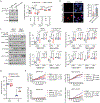Aberrant ATM signaling and homology-directed DNA repair as a vulnerability of p53-mutant GBM to AZD1390-mediated radiosensitization
- PMID: 38354228
- PMCID: PMC11064970
- DOI: 10.1126/scitranslmed.adj5962
Aberrant ATM signaling and homology-directed DNA repair as a vulnerability of p53-mutant GBM to AZD1390-mediated radiosensitization
Abstract
ATM is a key mediator of radiation response, and pharmacological inhibition of ATM is a rational strategy to radiosensitize tumors. AZD1390 is a brain-penetrant ATM inhibitor and a potent radiosensitizer. This study evaluated the spectrum of radiosensitizing effects and the impact of TP53 mutation status in a panel of IDH1 wild-type (WT) glioblastoma (GBM) patient-derived xenografts (PDXs). AZD1390 suppressed radiation-induced ATM signaling, abrogated G0-G1 arrest, and promoted a proapoptotic response specifically in p53-mutant GBM in vitro. In a preclinical trial using 10 orthotopic GBM models, AZD1390/RT afforded benefit in a cohort of TP53-mutant tumors but not in TP53-WT PDXs. In mechanistic studies, increased endogenous DNA damage and constitutive ATM signaling were observed in TP53-mutant, but not in TP53-WT, PDXs. In plasmid-based reporter assays, GBM43 (TP53-mutant) showed elevated DNA repair capacity compared with that in GBM14 (p53-WT), whereas treatment with AZD1390 specifically suppressed homologous recombination (HR) efficiency, in part, by stalling RAD51 unloading. Furthermore, overexpression of a dominant-negative TP53 (p53DD) construct resulted in enhanced basal ATM signaling, HR activity, and AZD1390-mediated radiosensitization in GBM14. Analyzing RNA-seq data from TCGA showed up-regulation of HR pathway genes in TP53-mutant human GBM. Together, our results imply that increased basal ATM signaling and enhanced dependence on HR represent a unique susceptibility of TP53-mutant cells to ATM inhibitor-mediated radiosensitization.
Figures







References
-
- Miller KD, Ostrom QT, Kruchko C, Patil N, Tihan T, Cioffi G, Fuchs HE, Waite KA, Jemal A, Siegel RL, Barnholtz-Sloan JS, Brain and other central nervous system tumor statistics, 2021. CA Cancer J. Clin 71, 381–406 (2021). - PubMed
-
- Helleday T, Petermann E, Lundin C, Hodgson B, Sharma RA, DNA repair pathways as targets for cancer therapy. Nat. Rev. Cancer 8, 193–204 (2008). - PubMed
Publication types
MeSH terms
Substances
Grants and funding
LinkOut - more resources
Full Text Sources
Molecular Biology Databases
Research Materials
Miscellaneous

